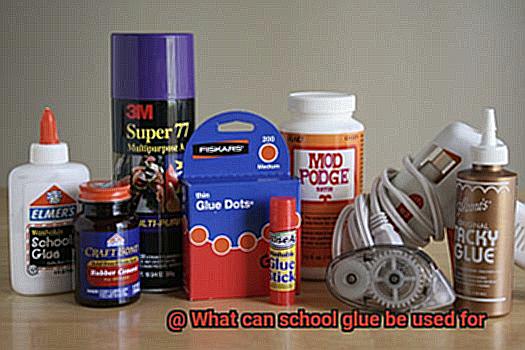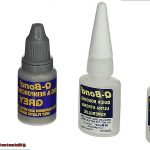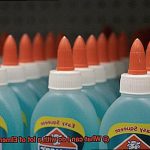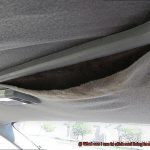There’s a new champion in town, and it comes in a humble little bottle – school glue. Sure, we all know it as the go-to adhesive for sticking paper together in classrooms. But did you ever stop to think about the hidden talents this unassuming glue possesses? Brace yourself, because we’re about to blow your mind with the mind-boggling ways school glue can transform your world.
Picture this: you’re at home, surrounded by broken things and unfinished projects. Fear not. School glue swoops in like a crafty superhero, ready to save the day. It’s not just for arts and crafts anymore – this sticky wonder has got your back when it comes to home decor disasters, DIY adventures, and even scientific escapades. And the best part? It won’t break the bank.
Whether you’re a parent trying to keep your kids entertained or an educator looking for some classroom magic, school glue is here to unlock your imagination. Together, let’s embark on a journey through the captivating universe of school glue and uncover its secret powers.
Get ready to be spellbound as we reveal how this seemingly ordinary adhesive can take your projects from “meh” to mesmerizing. Trust us, you won’t believe what this tiny bottle holds inside.
So buckle up and prepare to be amazed as we dive into the extraordinary uses of school glue that will make you see it in a whole new light. Are you ready for an adventure? Let’s get started.

Common Uses of School Glue for Arts and Crafts Projects
Contents
- 1 Common Uses of School Glue for Arts and Crafts Projects
- 2 Educational Uses of School Glue in Classrooms
- 3 Practical Uses of School Glue Around the House
- 4 DIY Projects with School Glue
- 5 Temporary Binding Agent Uses of School Glue
- 6 Nail Polish Barrier Uses of School Glue
- 7 Unconventional Uses of School Glue
- 8 Limitations of Using School Glue
- 9 Conclusion
When it comes to arts and crafts projects, school glue is a true hero. Its versatility and ease of use make it a go-to adhesive for artists and crafters of all ages. Whether you’re working on a school project or a DIY creation at home, school glue has a wide range of applications that will make your artistic endeavors shine. Let’s explore some common uses of school glue for arts and crafts projects:
- Paper Projects: School glue is perfect for sticking paper together, making it ideal for collages, paper mache sculptures, and other paper-based crafts. Its ability to spread easily and dry quickly makes it convenient for these types of projects.
- Decorative Embellishments: Take your crafts to the next level with decorative embellishments. School glue can be used as a sealant to secure glitter, sequins, or other decorations onto your creations. By applying a thin layer of glue over these embellishments, they become more secure and long-lasting.
- Homemade Slime: Slime has become a sensation in the crafting world, and school glue is one of the essential ingredients. Mix school glue with other ingredients like borax or contact lens solution to create a stretchy and gooey substance that kids (and adults) love to play with.
- Lightweight Materials: School glue provides a strong bond without damaging lightweight materials like foam, felt, or fabric. It is great for sticking these materials together in various craft projects.
- Masks, Puppets, and Jewelry: Let your imagination run wild with school glue. It can be used for making masks, puppets, or even jewelry. Its versatility makes it suitable for many different types of crafts.
In addition to these common uses, school glue has many other practical applications. It can be used in classrooms for educational purposes, such as creating visual aids or interactive learning materials. It can also come in handy around the house for repairs or DIY projects.
However, it’s important to note that while school glue is versatile and easy to use, it may not be suitable for all projects. Its adhesive strength is not as strong as other types of glue, so it may not be suitable for heavy-duty repairs or projects that require a long-lasting bond.
Educational Uses of School Glue in Classrooms
School glue is not just your ordinary adhesive; it is a superhero tool that can transform your classroom into a hub of creativity and learning. With its magical ability to bond materials together, school glue can elevate arts and crafts projects, engage students in hands-on activities, and reinforce important concepts across various subject areas.
In this blog post, we will explore the educational uses of school glue in classrooms, highlighting its versatility and benefits for teachers and students alike.
Arts and Crafts:
School glue is the go-to companion for arts and crafts projects. Whether it’s creating collages, assembling three-dimensional models, or decorating artwork, students can explore their creativity while improving their fine motor skills.
The easy application of school glue allows students to manipulate the bottle with precision, honing their dexterity as they bring their ideas to life.
Science Experiments:
In science classrooms, school glue becomes an essential tool for hands-on investigations. Students can use it to explore concepts of adhesion or secure objects during physics experiments.
This interactive approach enables students to actively participate in the scientific process, fostering a deeper understanding of scientific principles.
Language Arts:
Teachers can use school glue to make language arts activities more engaging. By providing cut-out letters or words, students can arrange them into sentences or paragraphs using glue.
This activity not only reinforces spelling and grammar but also encourages creativity in writing.
Mathematics:
Visualizing mathematical concepts becomes easier with school glue. Students can create geometric shapes by gluing polygons together, enhancing their understanding of area and perimeter.
Additionally, glue can be used to create graphs or charts by attaching labels or data points, helping students interpret and analyze mathematical information.
Social Studies and History:
School glue becomes a time-traveling tool in social studies and history lessons. Students can create timelines by attaching important dates or events onto a long strip of paper.
This visual representation aids in comprehending the chronology of historical events and their significance.
Teamwork and Collaboration:
Group projects are an integral part of the classroom experience, and school glue promotes teamwork and collaboration.
Students work together to assemble their final products, learning valuable skills such as effective communication, responsibility sharing, and problem-solving as a team.
Conclusion:
School glue is not just an adhesive; it is an educational tool that sparks creativity, engages students, and reinforces important concepts across various subject areas. From arts and crafts to science experiments, language arts to mathematics, school glue is a versatile resource that enhances learning in classrooms.
Whether you’re a teacher looking for innovative teaching methods or a student eager to explore your artistic side, unleash your creativity with the magical powers of school glue.
Practical Uses of School Glue Around the House
School glue is not just for the classroom. This versatile adhesive has superhero-like abilities that can save the day in many practical ways around your house.
From crafting to repairs and even homemade cleaning solutions, school glue can be your go-to tool. Let’s explore its practical uses together.
Crafting and DIY Projects:
When it comes to crafting and DIY projects, school glue is a powerhouse adhesive. Here are a few ways you can put it to use:
- Handmade cards and scrapbooking: Bond paper, fabric, and lightweight wood to create personalized cards or preserve memories with beautiful scrapbooks.
- Model building: Bring your creations to life by securely bonding materials like cardboard and wood for dollhouses or model airplanes.
Temporary Adhesive:
Sometimes you need a temporary fix that won’t damage your walls or surfaces. School glue has got you covered:
- Wall decor without damage: Hang decorations or artwork on walls using a small dab of glue instead of nails or tape, leaving no residue behind.
- Seasonal displays: Attach holiday decorations to windows or mirrors without worrying about them falling off.
Household Repairs:
Don’t let minor repairs get you down. School glue can help you fix things up in no time:
- Fixing ceramics: Repair broken mugs or plates by applying a thin layer of glue to the broken edges and pressing them together.
- Minor furniture repairs: Bond loose chair legs or fix small cracks in wooden surfaces with a touch of school glue.
Home Décor:
Add some flair to your home with these creative uses of school glue:

- Revamp plain objects: Apply school glue in patterns, swirls, or personalized designs on lampshades or vases, then sprinkle glitter or colored sand before it dries.
- Sealant for corkboards/bulletin boards: Protect and extend the life of cork surfaces by applying a thin layer of glue over them.
Sealing and Maintenance:
School glue can be your secret weapon for sealing and maintenance tasks around the house:
- Prevent further cracks/chips: Apply glue along minor cracks in glass surfaces or windows to stop them from spreading.
- Reattach loose wallpaper edges: Apply a small amount of glue to the back of the wallpaper and press it firmly against the wall.
Homemade Cleaning Solutions:
Harness the cleaning power of school glue with these homemade solutions:
- All-purpose cleaner: Mix equal parts white vinegar and school glue to create a powerful, natural cleaning solution for countertops, sinks, and bathroom fixtures.
DIY Projects with School Glue
Unleash your creativity with the magical powers of school glue. This versatile and affordable adhesive is a must-have tool for any DIY enthusiast, offering endless possibilities for crafting projects that will add flair and personalization to your life.
Let’s start with the ever-popular slime. With just a few simple ingredients, including school glue and household staples like borax or baking soda, you can create mesmerizing slime in an array of colors and textures. It’s a sensory experience that both kids and adults will adore, providing hours of gooey fun.
If you’re looking to add a decorative touch to your home, decoupage is the way to go. School glue becomes your artistic ally as you adhere paper cutouts or fabric pieces onto items such as picture frames, furniture, or glass jars. The glue not only provides a strong bond but also creates a protective seal, ensuring that your decoupaged creations withstand the test of time.
Why settle for store-bought stickers when you can create your own personalized ones? With school glue, you can bring your designs to life on paper, apply a layer of glue over them, let it dry, and voila. Peel off the sticker and stick it onto notebooks, cards, or even electronic devices. It’s a fun and imaginative way to add flair to your everyday items.
For those with a penchant for jewelry making, school glue is the secret ingredient for stunning creations. Use it to attach beads, rhinestones, or other embellishments onto jewelry findings like earring posts or pendant bails. The glue’s secure bond ensures that your unique pieces withstand the test of time.
But wait, there’s more. School glue is also perfect for papercraft projects like cardmaking or scrapbooking. It effortlessly adheres paper layers together and securely attaches embellishments like ribbons or buttons. The best part? The glue dries clear, leaving your paper crafts looking neat and professional.
And let’s not forget about those unexpected household repairs. Whether it’s fixing a broken vase, reattaching a loose sole on your shoe, or mending a torn book cover, school glue comes to the rescue. It provides a temporary or permanent fix depending on the situation. Just remember, while school glue is versatile, it may not be suitable for all repairs, especially those involving heavy objects or extreme conditions.
Temporary Binding Agent Uses of School Glue
Also known as white glue or craft glue, this seemingly ordinary adhesive is not just for permanent bonding. In fact, it can be used as a temporary binding agent in a wide range of projects. Let’s delve into the various uses of school glue as a temporary adhesive and discover how it can unleash your creativity.
Paper Crafts:
When it comes to paper crafts, school glue is a lifesaver. Whether you’re creating collages, scrapbooking, or making homemade cards, school glue securely bonds paper pieces together. Its transparent drying nature ensures that the glue doesn’t interfere with the visual appeal of your project.
Plus, if you make a mistake or want to change something later, fear not. School glue is easily removable, allowing for adjustments and alterations without damaging your work.
Fabric Projects:
Working with fabric can be challenging, especially when pinning delicate or slippery fabrics. Thankfully, school glue comes to the rescue. It can act as a temporary binding agent to hold fabric pieces in place before sewing or applying permanent adhesives.
Simply apply a small amount along the edges of the fabric pieces, and they’ll stay put until you’re ready to sew them together. The best part? The glue can be washed out or will dissolve over time, leaving no lasting residue.
Woodworking:
Woodworking enthusiasts know the struggle of holding small or intricate wood pieces together while waiting for permanent adhesives to dry. Enter school glue. This versatile adhesive serves as a temporary solution in woodworking projects.
The tackiness of school glue keeps the wood pieces in place, allowing for adjustments and alignments before applying stronger adhesives like wood glue or epoxy.
With school glue’s help, you can achieve precision and perfection in your woodworking creations.
General-Purpose Use:
School glue is not limited to specific crafts; it’s an all-around temporary binding agent. Whether you need to attach lightweight materials like foam or cardboard for temporary displays, hold temporary labels or notes on a whiteboard, or even tackle unexpected household repairs, school glue has got your back.
Its versatility makes it a go-to adhesive for a variety of creative and practical purposes. With school glue in your arsenal, you can explore endless possibilities.
Nail Polish Barrier Uses of School Glue
The solution to your nail art woes might just be sitting in your child’s backpack – school glue. Prepare to be amazed as we dive into the world of school glue and its incredible ability to serve as a nail polish barrier.
Discover how this simple hack not only protects your skin from smears and stains but also revolutionizes your nail art game. Let’s explore the various uses of school glue as a nail polish barrier.
The Benefits of Using School Glue as a Nail Polish Barrier:
Stain Protection:
Say goodbye to unsightly stains on your skin caused by errant nail polish strokes. By applying a thin layer of school glue around your nails before painting, you create an impenetrable shield that prevents polish from adhering to your skin. No more embarrassing stains to hide.
Effortless Clean-up:
Bid farewell to tedious clean-up routines involving cotton swabs and precision brushes. With school glue, all you need to do is wait for it to dry completely, and then simply peel it off along with any excess polish that may have strayed onto it. Cleaning up has never been easier or faster.
Precision Personified:
Achieve salon-worthy precision without setting foot outside your home. School glue acts as a guide, creating a crisp and defined edge around your nails. This is especially helpful when working with dark or vibrant shades that tend to reveal mistakes more prominently. Flaunt flawless nails every time.
Choosing the Right School Glue:
Not all school glues are created equal when it comes to being used as a nail polish barrier. Opt for non-toxic, washable, and water-soluble glues explicitly labeled as school glues. These types of glues are perfectly safe for use on your skin and can be easily washed off with soap and water. Steer clear of glues containing harmful chemicals or those that are difficult to remove, as they may cause unwelcome skin irritations or damage.
Unconventional Uses of School Glue
School glue is a classroom staple, but its unconventional uses extend far beyond the walls of education. In this article, we will explore the exciting world of school glue’s hidden superpowers and discover how it can be harnessed for everything from DIY projects to beauty hacks. Prepare to see school glue in a whole new light.
Wall Decor and Crafts:
Bid farewell to sticky tape and putty marks with school glue’s temporary adhesive power. Use it to effortlessly stick posters and decorations to your walls, and when you’re ready for a change, simply peel it off without leaving any residue. Transform ordinary objects into extraordinary works of art by mixing school glue with water to create your own decoupage medium. This glossy finish can be applied to vases, trays, and more, allowing your creativity to shine.
Fabric Magic:
Unleash your imagination by transforming fabric into three-dimensional masterpieces using school glue as a fabric stiffener. No sewing required. Simply mix glue with water and apply it to the fabric, creating bowls or sculptures that will leave everyone in awe. When it comes to quick clothing repairs or hemming, school glue can be your secret weapon. Apply a thin layer along the edge or tear, let it dry, and watch as it forms a strong bond.
Beauty and Fashion:
Prepare to be amazed by school glue’s unexpected role in the world of beauty. It can serve as a temporary adhesive for false eyelashes, providing a secure hold without any harm to your natural lashes. Take your nail art to the next level by mixing school glue with glitter or pigment for stunning designs that will make your nails the talk of the town.
Handy Household Helper:
School glue is not only reserved for artistic endeavors; it can also come in handy around the house. Fix loose or squeaky floorboards by applying a dab of glue between them for a strong bond. Reattach loose knobs or repair broken pottery with the trusty assistance of school glue. Plus, save money by creating your own wallpaper paste by mixing school glue with water.
Green Thumb Gardening:
Believe it or not, school glue has a place in your garden too. Use it as a non-toxic adhesive for grafting plants or securing cuttings to support structures. It provides a temporary bond until the plant establishes its own root system. Additionally, school glue acts as a protective barrier on cuts or wounds of plants, promoting healing and preventing infections.
Limitations of Using School Glue
School glue is a versatile adhesive that has become a staple in classrooms, craft rooms, and even households. Its ability to bond various materials together has made it a go-to solution for many projects.
However, it is important to acknowledge that school glue does have its limitations. In this article, we will explore the boundaries of school glue and discuss when it may be necessary to consider alternative adhesives.
Bonding Challenges:
One of the major limitations of school glue is its inability to effectively bond certain materials. It excels at sticking porous surfaces such as paper, cardboard, and fabric, but falls short when it comes to non-porous materials like glass, metal, or plastic. For projects involving these materials, specialized adhesives designed for their specific properties should be used.
Moisture Vulnerability:
Another limitation of school glue is its susceptibility to moisture. Being water-based, school glue can weaken or dissolve when exposed to humidity or water. Projects subjected to moisture, such as outdoor crafts or items in contact with liquids, require more durable adhesives like waterproof glues or epoxy resin.
Strength and Durability:
While school glue is effective for lightweight materials and general crafts, it may not provide the required strength for heavy-duty projects or long-lasting bonds. Woodworking or furniture repairs often demand stronger adhesives like wood glue or epoxy that can withstand stress and heavy loads.
Drying Time Considerations:
School glue typically takes longer to dry compared to other adhesives. This can be problematic for projects that require quick assembly or multiple parts that need immediate bonding. In such cases, fast-drying adhesives like cyanoacrylate (super glue) or hot glue guns may be more suitable alternatives.
Brand Quality:
It is essential to note that the quality of school glue can vary among different brands. Some lower-quality glues may have even more limitations in terms of bonding strength, drying time, and resistance to moisture. To ensure optimal results, it is advisable to choose reputable brands and read product reviews before purchasing.
Long-Term Durability:
While school glue can hold up well in many situations, it may not provide a permanent bond. Over time, especially with exposure to heat or constant use, the adhesive may weaken, leading to materials coming apart. For projects that require long-term durability, considering alternative adhesives or additional techniques such as sewing or stitching may be necessary.
zumPCy2wuKg” >
Conclusion
In conclusion, school glue is a versatile and essential tool that can be used for a wide range of purposes.
Whether you’re a student, a teacher, or just someone who loves crafting, school glue has got you covered. From creating art projects to repairing broken items, the possibilities are endless.
It dries clear and is non-toxic, making it safe for children to use.






